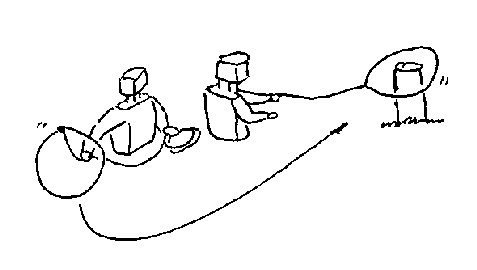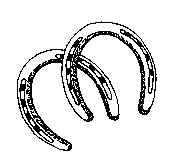




Next: Two Rope Tricks Up: The Lasso Previous: Butterfly Tricks
Please Read The Copyright Notice





Next: Two Rope Tricks
Up: The Lasso
Previous: Butterfly Tricks
If you show off some of your rope tricks in public someone will surely want to know if you can catch cattle with that thing. Then they'll want to see you do it! Well what could be more natural with a lasso? Catches have to be the most compelling archetypal images of the lasso and of the wild west.
This chapter describes a few catches with a trick rope. Although
catching with a trick rope is similar to what most cowboys do
to make a living there are some important differences. For one a trick rope is
not nearly as stiff as a cowboy's catch rope and usually not nearly as long.
Nevertheless,
you can catch with a trick rope, but be careful! Remember that if you successfully
catch an animal (like a dog, for example) you might not get your rope back without
getting bitten. Normally it's best to start with inanimate objects  fire hydrants, parking meters, and mail boxes are some ideas to start with.
Moreover, after practicing awhile on these sorts of things you'll almost
certainly attract the attention of some kids in the neighborhood who will
probably want to know if you can catch them. This will give you a perfect
opportunity to practice on moving targets and you'll probably get tired of it
before the kids will.
fire hydrants, parking meters, and mail boxes are some ideas to start with.
Moreover, after practicing awhile on these sorts of things you'll almost
certainly attract the attention of some kids in the neighborhood who will
probably want to know if you can catch them. This will give you a perfect
opportunity to practice on moving targets and you'll probably get tired of it
before the kids will.
In this chapter I describe three types of catches. The first type is made without spinning the rope and is simply called the Thrown Loop Catch. The second type is made from a Flat Loop. Finally, the most versatile and crowd pleasing catches are made from the Ocean Wave. In this book only a few catches of the many known are described. To explore this part of roping more thoroughly I refer you to [4], [5], [8], and [12] in the references.
An unspun, thrown loop catch is the catch most often made by a working cowboy. It consists of making an appropriate size loop and then throwing it towards the target, allowing enough of the coiled spoke to play out so that the loop can reach it.
The starting configuration for the Thrown Loop Catch is the same as that for the Butterfly. The diameter of the loop is adjusted to the size of the target and the excess spoke is coiled up into the left hand.
To make a Thrown Loop Catch, the loop is swung around the head several times and then thrown at the target. Extra spoke is played out of the coil in the left hand to allow the loop to reach the target. The idea is to make the loop open up into a circle thus making it easier to make the catch.
Making the loop open is accomplished by giving the loop a slight spin. Figure 6.1 illustrates the Thrown Loop Catch and I'll refer to this figure while explaining the method for opening the loop.
It is the turning motion of the loop caused by the flick of the wrist which makes the loop open up into a circle. Since the loop only turns through 180 degrees for the Thrown Loop Catch the amount of spin must be carefully gauged as a function of distance between the roper and the target. If the loop spins too much before arriving at the target the catch can be ruined by deformation of the circle and/or entanglement of the loop with the spoke.
An amusing and surprising variation of the Thrown Loop Catch is the Kicked Loop Catch. Here the loop is laid on the ground so that the spoke and the loop lay across the right foot (see Figure 6.2). The left hand holds the excess coiled up spoke. To make the catch the roper turns 180 degrees counter-clockwise on the left foot. While turning, the loop is lifted and carried around on the right foot. Near the end of the turn the loop is kicked up and towards the target and (hopefully) catching it.
The Flat Loop Catch described in this section is based on the One-Handed Merry-Go-Round described in Section 2.1. The idea of this catch is that the Merry-Go-Round loop is pulled sufficiently vigorously from behind the roper to send the loop forward, upward, and over a target.
Referring to Figure 6.3 the solid loop is in the same position as that for the One-Handed Merry-Go-Round loop illustrated in Figure 2.2(b). The solid loop in Figure 6.3 shows the One-Handed Merry-Go-Round at a position about half way around the back. At this point the roper turns slightly towards the target pulling the loop in that direction and lifting it sufficiently to make the loop clear the top of the target as is illustrated by the two dotted loops in the figure.
From the moment that the loop is pulled towards the target this catch is very similar to the Thrown Loop Catch described in the previous section. The difference is that the loop is already open and spinning and, thus, no flick of the wrist is necessary. On the other hand since the loop is already spinning you will have to mitigate the spin so that the loop does not over-spin before arriving at the target. This is accomplished by eliminating the quarter circle phase advance between the hand and the honda a little before the loop is pulled forward. At this point the loop is no longer spun by the roper (the loop, nevertheless, continues to spin) and the tension on the spoke is used strictly to pull the loop forward. The amount of pull applied to the spoke is a function of how rapidly the loop is spinning at the start of the pull and the distance of the target from the roper.
The rolled out position of the final loop in Figure 6.3 should be reminiscent of the position of the loop in Figure 5.4(a) used to describe the principles of the Arm Roll. From the point of view of spin acceleration these two tricks are similar. The vigorous forward pull of the Merry-Go-Round loop requires spin acceleration in advance of the pull since the hand and spoke are going to be unable to maintain the quarter circle phase advance between the hand and the honda as the loop rolls out for the catch. An important difference between these two tricks, however, is that for the Merry-Go-Round Catch it is undesirable for the loop to continue turning once it is completely rolled.
An nice variation of the One-Handed Merry-Go-Round Catch can be made by combining it with a Flat Loop Lift. The idea of the catch is to do a Flat Loop Lift when the Merry-Go-Round loop starts to pass from behind the roper to the front. The lifted loop is then guided forward and over the target.
Assuming that the target is in front of the roper the Merry-Go-Round is begun as usual. When the loop gets to the position illustrated in Figure 2.2(b) the Flat Loop Lift is begun and the loop is pulled to the front of the roper. This is to be compared with Figure 2.7(a) where the Flat Loop Lift is pulled diagonally from the right to the left of the roper.
The Ocean Wave catch is more difficult to master than any of the Flat Loop catches but it is also a very effective and satisfying catch. The idea of this catch is to sweep a Reverse Butterfly loop across the target so that the bottom part of the loop is stopped by the target while the top part of the loop passes over the top. In this way the top part of the loop passes over the target, falls down over the other side of it, and makes the catch.
Assume that the target is directly in front of the roper. The roper does an Ocean Wave based on a Reverse Butterfly spin passing the loop behind the body from left to right as described in Section 5.6. The usual spin acceleration used to carry the Ocean Wave around the back is not sufficient since it is necessary to apply a lot of extra pull on the loop to carry it forward for the catch. Practically all the roper is doing while the loop is behind the back is pulling on the loop, thus, extra spin acceleration must precede the pull. This is exactly the same idea as presented for the Flat Loop catches in the previous section.
To avoid tangling the spoke in the loop as it passes over the target the catch must be timed so that the honda is at 9 o'clock at the moment that the loop contacts the target. This is illustrated on the right side of Figure 6.4. The left side of Figure 6.4 is identical to the position of loop ``D'' illustrated in Figure 5.9 used for the description of the Ocean Wave.

As shown in the left side of the figure the loop comes from behind the back at the end of the Ocean Wave with the honda positioned at 12 o'clock. It must go through another one and a quarter turns before the loop passes over the target. Mastering the timing of this turn is probably the most difficult part of the catch. As in the Merry-Go-Round Catch it is important to keep in mind that the loop is not spun but pulled towards the target. The loop should already have all the spin acceleration necessary to keep it from closing. The trick is to gauge the amount of spin and the distance to the target in order to apply the amount of pull necessary to properly make the catch.
The final phase of the Ocean Wave catch can be practiced by working on the Turn-Around Catch. To perform the Turn-Around Catch the roper begins with a regular Butterfly and with his or her back to the target. As the Butterfly loop is passed to the left side the loop is given extra spin-acceleration and the roper turns to the left (i.e., counter-clockwise) pulling the loop around and towards the target to make the catch.
The Turn-Around Catch is identical to the last part of the Ocean Wave catch except that the pull of the loop for the Ocean Wave Catch is made while the roper is facing the target. The advantage of the Turn-Around Catch is that it can be practiced without having to first master the Reverse Butterfly or the Ocean Wave.





